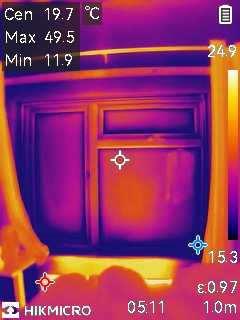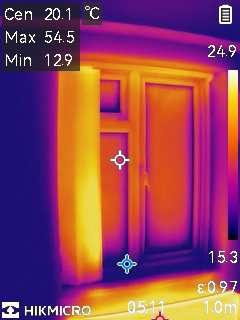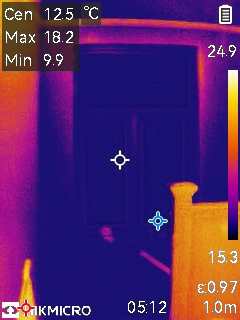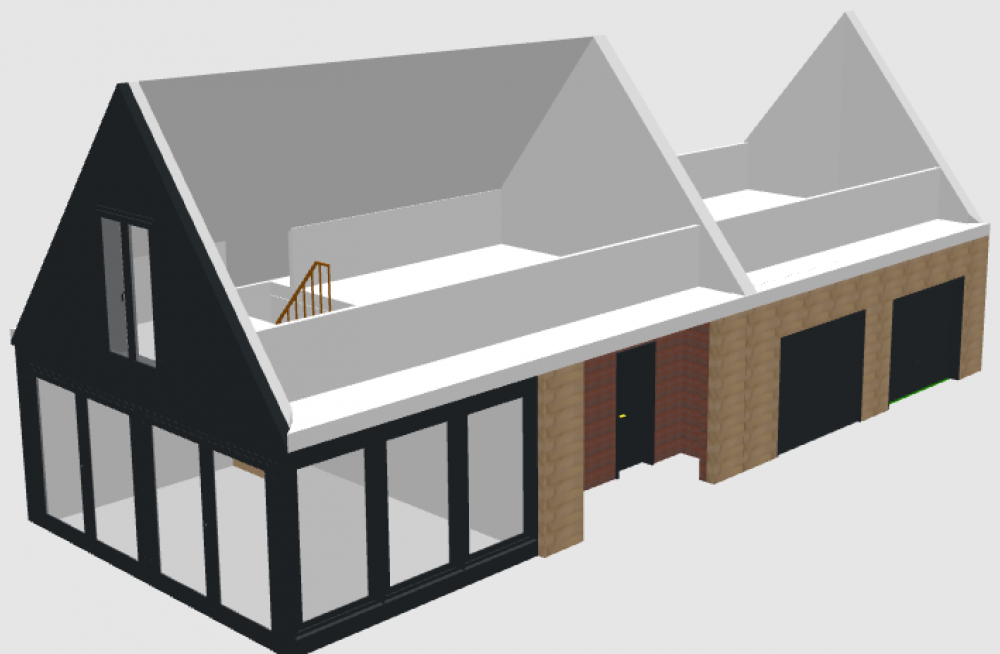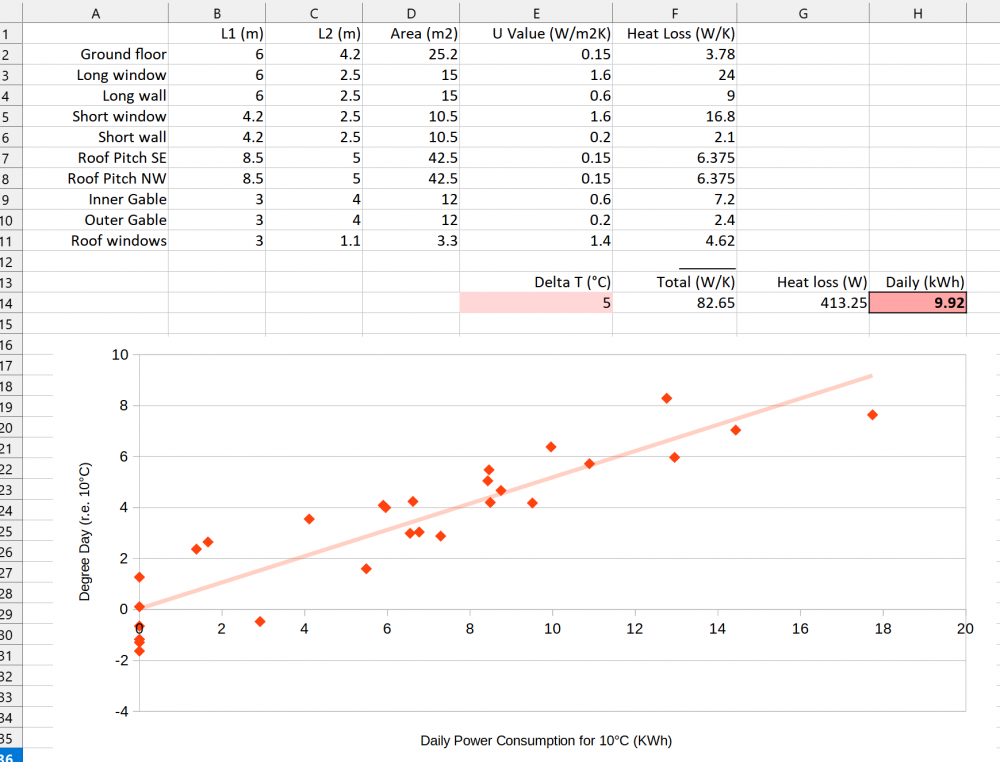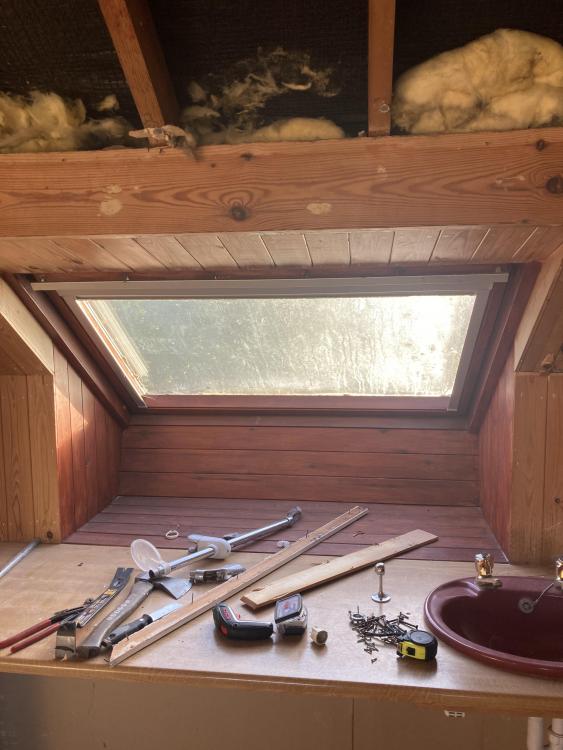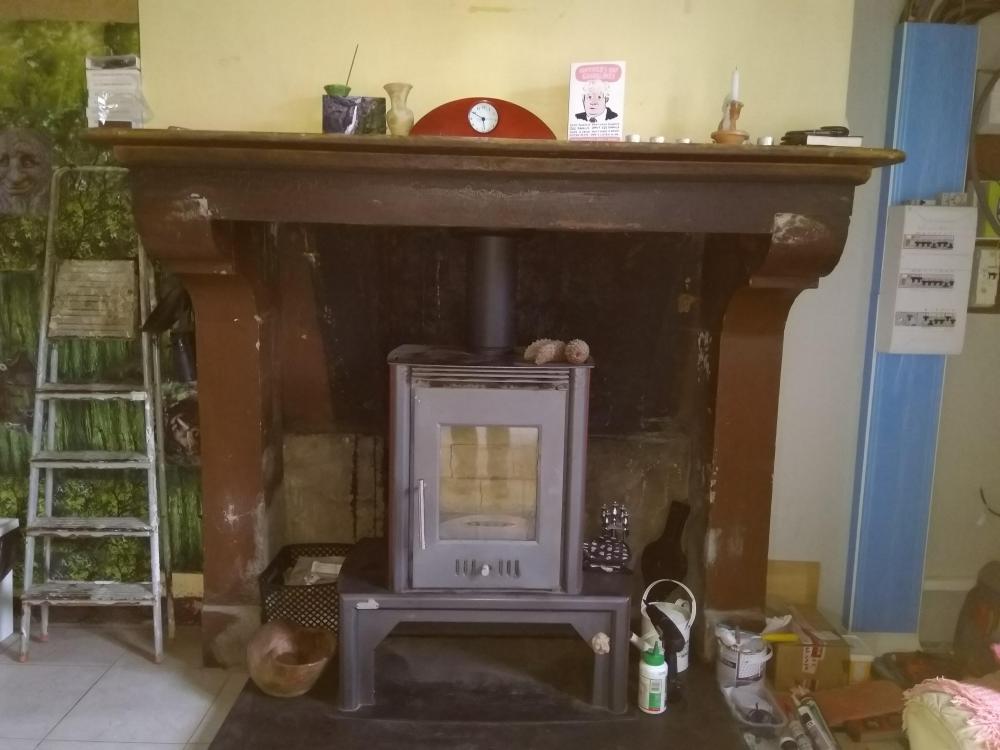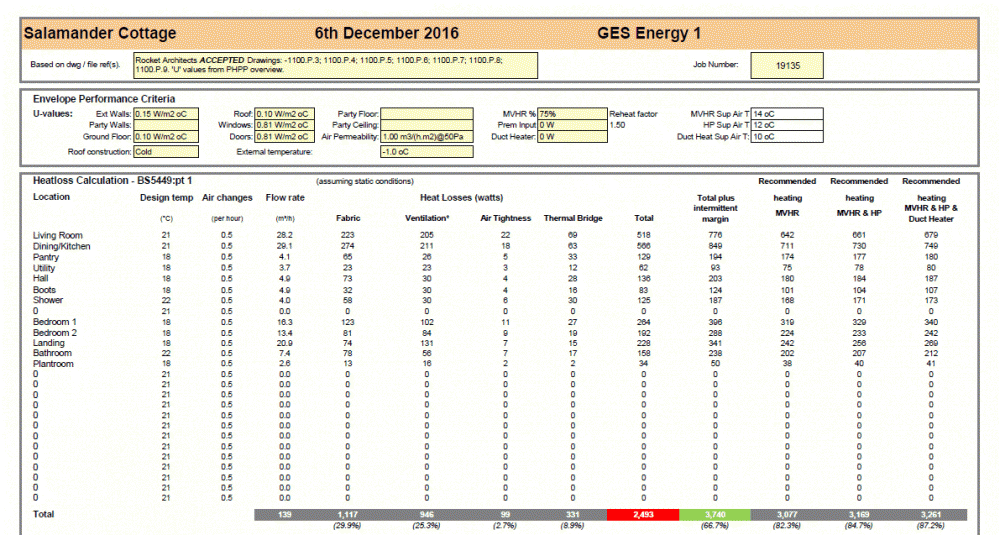Search the Community
Showing results for tags 'heat loss'.
-
Hello, I only joined the community yesterday, so apologies in advance for any misunderstanding on Forum Theme. My house was built circa 1975 - and had the old-style chimneys. It doesn't probably have sufficient cavity insulation etc. as it does in all modern buildings. I suspect I am having major heat loss through my Double-Glazed Windows. Although, they are structurally OK, from Thermal Imaging they seem like the biggest spots of heat loss. To clarify, I have attached the thermal images for consideration. My questions for the community are: 1. Considering the Thermal Images are taken inside the property, Do I have major issues with Windows? 2. Do I need to replace with more modern Catchment Windows (Without having to go through Council Paperwork)? Regards,
- 14 replies
-
- heat loss
- double glazing
-
(and 1 more)
Tagged with:
-
We recently had an Aira chap round, (long warranty). Told us a 6kW ASHP would be ok. We're not eligible for a grant because the previous tenant had one installed (even though the grant was £750 over 10 years ago). (We removed the 2012 ASHP—it was a noisy machine, and we’re after something quieter and more efficient - (is this the right thinking?) it's still in the garage). My partner is all for buying new (with a long warranty) I'm up for taking a chance as there's some good value machines out there. - What system would you have if you were to do it again ? Current thinking is 2 zone 60ish m2 under floor heating 16mm pipes 100mm centers + radiators up stairs - aiming to have a low flow temp and take advantage of the thermal mass of the thick walls and floor Looking forward to hearing your thoughts, especially considering the low flow temperature target and potential ASHP options (new vs used) - what should we have on our shopping list - ? Background We bought an old (1850 stone built ) drafty damp house with an ASHP that needed a complete overhaul / insulating / damp problems solving... it's been quite a journey but we now have windows.. so thats nice.. Current Setup Plan: Heating Zones: Ground Floor: ~60 m² underfloor heating with 16mm pipes at 100mm centres. First Floor: Radiators. Aiming for a low flow temperature to maximise efficiency and leverage the thermal mass of thick stone walls and the floor. Heat Loss Calculations: I did some rough heat loss calcs based on U-values from ChangePlan's U-Value Calculator. Heat Loss Breakdown: Area m² U-Value Temp Diff (°C) Heat Loss (W) Extension Walls 44 0.179 25 196.9 Stone Walls 48 1.26 25 1512 Windows & Doors 20.38 0.82 25 417.79 Old Roof 71 0.14 25 248.5 New Roof 34 0.147 25 124.95 Old Floor 56 0.22 25 308 Extension Floor 29.8 0.163 25 121.44 Total Fabric Heat Loss 2929.58 W Ventilation Heat Loss: Volume (m³) ACR Constant Temp Diff (°C) Heat Loss (W) 365.5 1 0.33 25 3025.46 Total Heat Loss (including 20% buffer): Fabric: 2929.58 W Ventilation: 3025.46 W Total: 7364.44 W (7.36 kW)
-
Hi wise forum people, I'm in the process of getting quotes to replace an oil boiler with an ASHP for my farm house. I've got two quotes now in place, one of which was nice and detailed with all the heat loss metrics, and the other which just listed suggested radiator replacements. Despite this, after some discussion, the radiators they both suggest to replace match fairly well, except for the lounge. After a bit of questioning, I got some figures for the less detailed quote and am now having difficulty comparing the two. Company A (detailed quote) say the heat loss of the lounge is 2800 watts, and company B stated 4700 watts. I could understand a little variation, but this seem like a large difference. Further confusion comes in when I compare what each company suggests the CURRENT radiator will produce: Company A: 782 watts Company B: 1732 watts. The both correctly identified the rad as a K2 1000 x 600 mm, and I'm assuming they MUST have to use the same MCS methodology and flow rate and target temperature. There is clearly something funny going on. Does anyone have any ideas what, and if there are other methodologies that could be at play? Thanks.
-
I'm unsure if this is best posted in Boffins corner or MVHR being ventilation heat loss related. When planning my self-build heating and ventilation system, I've learned a lot of things, but some are a little out of my grasp to fully understand. It's very theoretical and I'm unsure how some of it plays out in the real world. So, I'll post what I have, and see if anyone with a good understanding of it all can advise me or correct anything I'm wrong with. You can over size or undersize a heating system, but undersizing is a more of a concern to me, especially with under floor heating pipe spacings. The property will be 200m2, masonry cavity wall construction. Without going into every sealing detail I've researched, I'll be applying a lot of attention to airtightness and aiming for the lowest score I can. I'd like to achieve 2ACH @50PA if possible and will have MVHR installed. I've completed a heat loss survey using some popular software, & tried various things to see how it impacts the end result. Being a self-build, I've been lucky enough to obtain the exact U values for all of the construction materials I'll be using, from the manufacturers, but there's still a couple of things that could have a large affect on my total heat loss. My maximum heat loss will be 5.7Kw, this includes me selecting the exposed area tick box to all rooms with an outside wall. I believe this adds 10% on, so if I removed it, the property could be 5.1 Kw I selected it to air on the side of caution with it being detached and 3 miles from the NW coast in the lake district, where the wind and rain can be heavy at times. I was told that this has less impact on properties with good levels of airtightness, should I leave it on or remove it? Airtightness: The heat loss software defaults most rooms to 0.5 ACH, except, Kitchen 1.5 ACH Toilet 1.5 ACH Bathrooms 1 ACH I believe 0.5 ACH derives from the worst case air pressure test result to obtain a pass. Building regs lowest pass limit was 10 ACH@50 PA, (Now apparently 8 ACH) which is terrible, I'd expect an average new build to be around 5, higher standard 2 ACH, and passive house 0.6 ACH. 10 ACH @50PA / 20 = 0.5 ACH. Is 20 the correct figure to divide by? If I achieved 0.2 ACH @50PA / 20 = 0.1 ACH. This lower air change per hour, input to the heat loss software would severely reduce my property heat loss. Without trying it yet, I'd guesstimate to be 3.5Kw which I'd not feel confident was realistic. If I should reduce the ACH from 0.5, how much do you scale the other rooms by with higher values? Do I play it safe and leave the ACH at their defaults, and if wrong, at least it's consistent for all rooms. Once the MVHR design is complete, their room by room air flow rates will likely affect this again, which I've glanced at, but one step at a time. The MVHR designer doesn't factor in heat loss and heat engineers don't factor in MVHR ventilation rates.
- 19 replies
-
Ages ago I wrote a spreadsheet for doing what-if comparisons to see whether it was better to invest in more insulation in the walls, roof, floor, fit better windows and doors, or fit a better MVHR system. Others have found it useful and I've been reminded that I've not re-posted it over here, so here's the latest version. It should be self-explanatory, you fill in the cells with your wall, roof/ceiling and floor areas, add the areas of each door and window, put in the U values for each and, if you can, get hold of the met data from the met office for your area (the data in there is for West Wiltshire, right on the border with Dorset). This isn't a thorough modelling tool, it just looks at heat loss fairly accurately but doesn't take into account heat gains, although there is a crude way of doing that by drawing a line across the seasonal plot at the point where you don't use heating and you can very roughly assume that anything above that line will be heating. Please feel free to ask any questions, but bear in mind I wrote it back when I was designing our house and haven't used it for a couple of years. so I may be a bit rusty. Heat loss calculator - Master.xls [edited to add latest version of the spreadsheet]
- 127 replies
-
- 9
-

-

-
- heat loss
- ventilation
-
(and 4 more)
Tagged with:
-
Hi, have a question about incorporating the impact of MVHR when calculating heat loss. Background: New ICF build near completion. My Heat pump installer has calculated I need 8kw of heat at -1/21. However, after incorporating the 90% efficiency of MVHR into heat loss calculations, this drops to 6.5kw. This was done by reducing heat loss through ventilation to 10%. This also synchs with my UFH room by room heat demand calcs. Theoretical efficiency of the MVHR unit is over 95%, and my u-values are conservative, eg I have double bubble-wrap foil under roof but have ignored its additional R value. Same with impact of plasterboards, render etc. So fairly confident about the stated heat losses not being more. Issue: My heat pump installer INSISTS that I should ignore the MVHR because it could fail and if that happens in the middle of -1 degree winter I need to have additional capacity for heat. He wants to install a bigger system to suit the 8kw demand. The change to the bigger unit means my outside unit will double in size, which I absolutely do not want unless I really have to. My arguments has covered the following, none of which has convinced him: - extra cost of bigger system (£1,000) will take years to be recovered through multiple failures of MVHR just when outside is really cold - even ignoring the upfront costs, having to supplement heating with electric radiators/fans for a couple of weeks every few years (IF the MVHR fails), is not actually that huge. - MCS has been non-comittal on this and says it is a design issue for the installer to decide - What happens if the heat pump fails? What happens if there is no power for 10 days? Why do we need to assume the MVHR fails? But not anything else? What am I missing here? I realise I am a little on the borderline with the 6kw system which only has a couple of extra 100 watts of power at -1 outside, but I am quite prepared to supplement that with normal electric heating when I have to. MCS have not objected, and it is my risk to take. Any advice? Is there a rule about excluding the impact of MVHR when calculating heat losses? It is just so incredibly odd that my installer wants to disregard the heat recovery impact when working out ventilation heat losses, which sure.y goes against the spirit of MCS. Thank you!
-
Hi, perhaps someone with more experience than me can help. My gas usage for the last year is around half that suggest by a recent MCS ASHP survey. I really don't want to pay for and live with a double height HP unit if its not needed, but don't want to undersize either. I live in 160m2, 4 storey mid terrace house in Bristol. C 1870 Extended to the rear and loft so half of the exposed walls are essentially new build levels of insulation and air tightness. Floors are fairly well insulated. Mixture of rads and wet UFH. Fully double glazed, half the exposed walls are 300 and 400mm uninsulated solid brick/ stone. as mentioned we are looking to install an ASHP. my measure gas usage does not match the ASHP installers calcs. My figures for heat loss at at -2c are 4- 5kw and theirs come out at ~9kw. (i calculated this from measuring gas usage over the year, used degree days to establish a heat loss per degree difference in/out. then see what it gives at -2c ) Annual usage is equally off. Our gas usage was 9000kwh for the year and the calcs suggest 19000kwh. (no calculation by me on these numbers) For refence that gives a measured value of 56kwh/m2 vs calculated 119kwh/m2 Finally I ran our combi at 40 degree flow for the past winter (coolest average day was 2c ) and maintained 20degree internal temp fine. but the calculation suggest the radiators would only keep interior temp of 20c with flow of 55c and outside temp fo 3 degrees. which would be far from ideal. Do calculator tend to over estimate? I have worked hard to reduce drafts, perhaps the clacs are based on an assumption for an old drafty house ? any advice on if my measured figures seem plausible? The renovation has been done well but not to enerPHit. opinions on whether oversizing or under sizing is the better option welcome. Our primary aim of ASHP is CO2e reduction not financial. Thanks in advance. Joe
-
My recently built garage/workshop extension looks roughly like this: The new glazed pavilion and floor above has been added on to our original workshop/garage. The intermediate gable was demolished at first floor level to create one large room above. Regrettably the insulation levels are to building standards only, and no heating has yet been installed. I did put in a UFH loop in the ground floor screed in preparation though. Unfortunately this was all planned and constructed when energy costs were nothing like the major issue they are now. Now I'm trying to figure out what kind of heating to put in to make it usable all year round, so I've been collecting data on the actual thermal performance comparing it with some rough heat loss calculations and I'm not sure if it all stacks up. All I've done is very crudely worked out the fabric heat losses (the original cavity walls are more like guesses) and put in a 2kW digitally controlled heater set to 10C, monitoring daily power consumption vs. mean outside temperature. As shown above, the loss calcs suggest 10kWh for a 5C delta. The actual data agrees with this almost exactly but I'm suspicious! After all, there's no account taken for air exchange and there's been no other heat input during the monitoring as the place is currently unoccupied. Should I trust this experiment and base my heating decisions on it?
-
Hi, I am new to this group. I have a question about insulation to my roof in a loft style room. Please see pictures attached. Any advice what is better to use, 100 PIR or rockwool slab 100? Many thanks. Alfred
-
My heads away with so much build stuff rushing about in the mush of my brain. Just wanted to sense check my thoughts. I am using @JSHarris heat loss spreadsheet which is a great job. When people quote their calculated heat loss is it this field that they refer to (Total heat loss)?
-
Hello, We have insulated the whole of our 1940 house from the inside using rigid fibreglass bats and plasterboard. Its previous insulation value was very poor in solid brick. We are on the last room which has a large stone fireplace with a wood-burning stove in it, on an external wall. We use this in winter but not everyday. I do not want this to be a cold spot when not in use and a huge heat loss when it is in use. I have about 4 to 6 inches to play with and still maintain a good air gap behind the stove but I am not sure what materials to use for both maximum efficiency and fire safety. What suggestions do members have for this scenario? I should add that it has a flue pipe through to the top of the chimney with a proper watertight top plate and an insulated one at the bottom. Advice would be most appreciated
-
Hi, I hope this is the best place to post this. Please let me know if I'm in the wrong area :) Ok, so I have a room with a very high ceiling (approx 8.5m high), which I need to perform a heat loss calculation on. My understanding is that when convection is taken in to account, we don't have to allow for the entire cubic volume of the room, as people will only be occupying the first ca. 2m from ground to just above head height. I'm on board with the whole idea of heat energy moving from hot to cold, but it just doesn't seem right to have to allow for an almost 3.5x heat loss as we have to assume that the entire cubic volume of the room is heated, as well as the entire surface area of the external walls. It feels like I'm missing a correction factor for convection. Does anyone have any experience with this kind of heat loss? Thank you very much BB24
-
Sometimes questions are raised as to whether it's worth increasing insulation levels and often there seems to be confusion as to what the "ideal" level of insulation is, or even what a "good" or "reasonable" level of insulation might be. I'm not sure whether or not the non-linear impact of improving insulation, in terms of the effect on the heating requirement, and hence running cost during cold weather, is widely understood. I've heard comments like "it's not worth improving the insulation from 0.16 W/m2.K to 0.12 W/m2.K because it would be 30% more expensive and only reduce the heat loss by 25%". Most of the time this is incorrect, because homes have heat sources all year around, from the occupants, incidental heating from appliances, solar gain and even pets (a medium sized dog is probably a four-legged 40 - 50W heater). So, I thought a really simple example might help some gain a better understanding of this non-linearity, and illustrate better why some are so evangelical about trying to improve insulation levels (and reduce ventilation heat loss, too, but I'll get to that another time). Let's build a pretend house, that for simplicity has no doors or windows and is a rectangular single storey box with a flat roof. For simplicity we'll assume it's on raised piles, with an air space underneath, just so we can use the same insulation level on all six sides and to make the sums simple. All I'm doing here is making a comparison, so this is a valid way of illustrating this effect. In our rectangular box house we have an average of 100W of incidental heating, coming from things like internet kit, a PC, a cordless phone base station, a TV, a phone charger, a few lights and a handful of intermittently used kitchen appliances. This is a pretty low figure - I struggle to keep our house background load below about 200W, without any lights on. The box houses two adults, giving out around 80 - 100W each and a dog, so lets say there is 220 W of heating coming from the occupants. The box also has a heating system that can deliver whatever power is needed to maintain a temperature of 20 deg C inside, and its night time, so there's no solar heating of the walls. Outside it's 5 deg C, a chilly winters night. This rectangular box is 10m long x 10m wide x 2.5m high inside, so has a total wall, floor and roof area of 300m2 and an internal floor area of 100m2, so fairly average in size (a bit bigger than our current 3 bed bungalow). So, we have a temperature difference between the inside and outside of 15 deg C (20 deg C - 5 deg C), an internal surface area of 300m2 and a constant incidental heating level of 320 W (220 W from two adults and dog, 100 W from electrical appliances and lights). First, lets see how much heat we need to put into this box from the heating system, if we have U values for the walls, floor and roof of 0.2 W/m2.K (K is degrees Kelvin, the same units as degrees Centigrade when only temperature difference is being compared): The total heat loss power, in Watts, can be calculated from the U value, the area and the temperature difference, so for this first example we get 300m2 area x 15 deg C temperature difference x 0.2 W/m2.K U value = 900 W. There is 320 W of heat coming from the occupants etc, so the heating system would need to deliver 900 - 320 = 580 W in order to keep the house at 20 deg C under these conditions. If this were by direct electric heating, then the heating cost would be about £2.09 per 24 hours. Next, let's see how much heat we need to put into this box from the heating system, if we have U values for the walls, floor and roof of 0.1 W/m2.K , in other words, we've made the insulation twice as "good", so might think we've halved the heating cost: The total heat loss power is now 300m2 x 15 deg C temperature difference x 0.1 W/m2.K U value = 450 W. This is what we'd expect, double the insulation effectiveness and halve the heat loss. However, when we now take away the incidental heat gain from the occupants, etc, of 320 W, the heating system needs to deliver 450 - 320 = 130 W in order to keep the house at 20 deg C under these conditions. If this were by direct electric heating, then the cost would be about £0.47 per 24 hours. So, by doubling the insulation level we've decreased the heating cost by about 78%, not the 50% that might have been expected. This is a very simplistic example, but it does illustrate why doubling up in insulation can give a far greater benefit than might be expected. It also shows why, when you improve the level of insulation you can reduce the heating requirement down to such a low level that for a lot of the time you don't need any heating. In that last example, turning on a few extra lights could heat this imaginary box home to a comfortable temperature on a cold night, whereas with only half the insulation it needs something that delivers 446% more heat.
- 31 replies
-
- 5
-

-

-
- insulation
- heat loss
-
(and 4 more)
Tagged with:
-
Hello Members, this is my first post and I'd like to say that I really appreciate Jeremy's Heat Loss Calculator, which took one day to complete (yesterday). The compact one-page format with 'what-if' ability is very, very useful. Thank you Jeremy. These are my current considerations and I'd appreciate any comments and/or advice from members Regards, Hugh
- 6 replies
-
- heat loss
- ventilation
-
(and 4 more)
Tagged with:
-
Having downloaded Jeremy's Heat Loss Spreadsheet and populated it using figures supplied by the Architect, it tells me I have a Total Heat Loss of 5766 watts. (The higher than expected result apears to be driven by the number of windows we have). The question is - What Next? I assume I'll need to have some heat input to balance the Total Heat Loss of 5766 watts? I had in mind to install underfloor heating in the groundfloor slab and heat spreader plates and pipework in the kitchen / family room. (the house is basically an upside-down house, with two bedrooms and a lounge downstair and a Kitchen/family room and dining room above.
-
I'm sticking this here as I've been asked the question via PM, and rather than just give an answer to one member, I thought it might be more useful to stick the answer somewhere were others can also read it. Back when I was first looking at doing some rough "what if" type comparisons, between different build systems, windows, insulation and airtightness levels etc, I wanted a fairly quick way to be able to change one element, say the wall U value, or the efficiency of the MVHR system, and see what impact it had on the overall heat loss of the house. This model was never intended as a substitute for something like PHPP, which is very comprehensive, it was just intended to give a rough idea so that I could see the scale of some of the changes, and work out where best to spend our limited budget. Having written the spreadsheet for our build, others expressed interest in using it, so I tidied it up and let others have a copy. Because lots of people seemed to want to use it, and also because it generally seemed to give results that were within 10% or so of more complex models, like PHPP, I put a copy of the spreadsheet up on our website, as a free download: http://www.mayfly.eu/wp-content/uploads/2017/01/Fabric-and-ventilation-heat-loss-calculator-Master.xls This post is a set of very brief instructions on using this spreadsheet. First some health warnings. It was never intended to give an absolutely accurate prediction of heat loss, and as such it takes no account of solar gain, wind or incidental heat gain from occupants and appliances. As a consequence it is generally a bit pessimistic, in that it will usually tend to slightly overestimate the heating requirement. This is not necessarily a bad thing, as it can be useful to have a bit of heating capacity in reserve for exceptionally cold weather. To use the spreadsheet, you first need to gather all the data needed to complete the white cells. Most of this should be self-explanatory from the notes in each section. The U values, for example, should be the true U value of the component, including any additional thermal paths, so the window U value needs to be the Uw value, not the Ug value, and the floor U value needs to be adjusted for any thermal bridging around the periphery. All the areas are the internal wall, floor and ceiling/roof areas, not the external ones. The model does not account for geometric thermal bridging at corners, but in a well-insulated house this effect should be very small, anyway. Some of the most difficult to obtain data can be the mean daily air temperature and the mean minimum daily temperature, for each month. This data is available for your location on the Met Office website, but posting a link seems a bit fraught, as the Met Office keep changing their website and this makes any link out of date fairly quickly. All I can suggest is that you work your way through the historic data on the Met Office website and find that closest to where you live. Once all the data is filled into the white cells on the spreadsheet, you should get some numerical data in the green cells, plus two graphs will appear. The graphical data is often the most useful. First, there is a basic heat loss versus outside air temperature plot (the Heat Loss Vs Delta T plot). You can use this to determine how much heat the house will need to maintain the room temperature that you put into the spreadsheet (it defaults to 20 deg C, but you can change this to whatever you feel comfortable with). The red line is the total heat loss, the other lines are there so you can see which elements are contributing the most to the total. If you want to know how much heat the house will need in order to maintain a temperature difference between inside and outside of 20 deg C (say a 20 deg C room temperature when it's zero deg C outside), then just go up vertically from the 20 deg C point on the horizontal axis until it meets the red line, then go across horizontally from this point to the vertical axis and read off the heating needed in watts. The other plot shows the heat loss per month, and this one can be a bit confusing, because, like the other plot, it takes no account of incidental heat gain, from solar heating, appliances, occupants etc. The best way to use this is to print it off and pencil a horizontal line across where you think you wouldn't have heating on. For example, If you turn your heating off in April/May and on again in September/October, then draw lines across at about the point where these dates cross the other lines and call that your "no heating" point. The mean heating needed for each month will then be the difference between those lines and the values on the plots. You can quickly work this out by just noting the amount of incidental heat gain, indicated by the pencilled horizontal lines, and then subtracting those values from the monthly values. Be aware that this is really a very rough estimating tool, as there will be big peaks and troughs in daily temperatures within those months that will effect the heating required. In most respects, the heat loss vs delta T plot is more useful for sizing a heating system. Hopefully the above should make some sense to anyone trying to use this tool.
-
This post is a deliberate attempt to expose my thinking on MVHR in the hope that someone will see a flaw in what is planned or be able to make a suggestion which -as has happened before- saves us from unnecessary errors and maybe even saves us a bit of money. What have I learned about MVHR before I got here? Avoid standing hot water pipe heat loss. Get the house air tight. Forget cat flaps. Visit lots of houses with MVHR (thanks @VIPMan among several others). Don't allow your postie anywhere near the front door. Forget normal keys. Open the windows if you like, and switch the system off if you like. Many people have MVHR and don't use it or worse, haven't been told how to use it. In the passiv or nearly passivhaus sector use PHPP (again thanks @VIPMan) to estimate your heat requirement (19 Watts per square meter per annum) - in our case 5 Watts short of a picnic. Watch for overheating (10% risk in our case) Getting from numbers on a spreadsheet to buying a system As I've said elsewhere, here be dragons. Let's be kind and say that MVHR isn't well understood. By sellers sometimes but by Jo Public in particular. I've been digging round for two or three years now, and frankly, my heart's still in my mouth. But I have moved on from looking at a house and thinking - oh yeah, lets put a bigger log burner in there... it'll be lovely. Poor life decisions in relation to pensions taught me that. Useful, relative penury sometimes. Makes me think more, and more deeply. So, I start with a PHPP print out, our plans and send it to a company that says 'We'll do a heat-loss calculation for you' Thanks very much Here is one claculation. Hmmm, much to explain there (for me anyway) Take the Total Column: that's the total in Watts of heat that is used: Living Room uses 518 Watts If you add a 50% factor for 'safety' you get 776Watts And (next column) it takes 642 Watts to heat it, ERGO, the MVHR recovers (776-518) Watts With a Heat pump inline (MVHR and HP) I'd recover (661-518) Watts With a heat pump and a Duct heater, I'd recover (679-518 ) watts Not sure what the percentages refer to..... (help @SteamyTea Bottom line, I'll need just over 3 kW of additional heat ; 3077, 3169, 3261 to heat the house to 21/ 22 ish (bottom line in grey) So, what does this tell you? There's two of us, a cat and two dogs: cat =10 Watts, dogs 100 Watts between them, @MrsRA 1kW (hot stuff ) me a bit less, so 2 and a bit kW. Put the hoover on, the oven and a few lights (no hot water see above) and we get close to just right- or needing to open the windows? Answers on a postcard please...............


